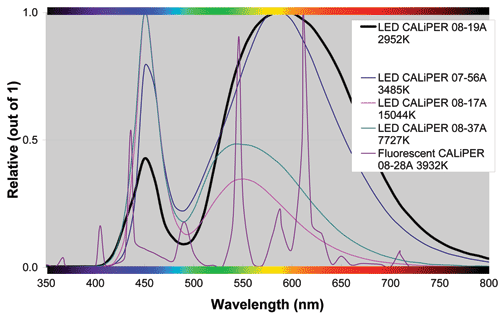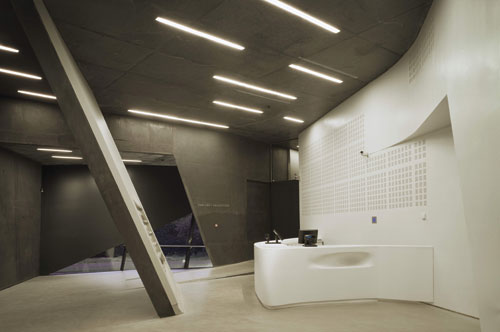Replacing the Fluorescent Lamp with Linear LED Luminaires
Linear LED Luminaires Versus Linear Fluorescent Luminaires
While there has been considerable DOE-driven literature on LED replacement lamps for CFL and linear fluorescent fixtures, there has been relatively little addressing linear LED luminaires as replacements for linear fluorescent lighting. However, the IES LM-79-08 photometric reports and manufacturer data sheets of the many newly introduced LED luminaires should provide design professionals with a helpful basis for evaluating products.
Length of LifeUnlike other light sources, LEDs usually don't “burn out”—instead, they get progressively dimmer over time (a process called lumen depreciation primarily caused by heat generated at the LED junction). LED useful life is typically based on the number of operating hours until the LED is emitting 70 percent of its initial light output (L70). Good-quality white LEDs in well-designed fixtures are expected to have a useful life of over 60,000 hours. High-quality linear fluorescent tubes (T8 and T5) using rare earth phosphors will lose only about 5 percent of initial lumens at 20,000 hours of operation. The life of a typical linear fluorescent tube ranges from 7,000 to 24,000 hours while the best linear fluorescent lamps can last more than 30,000 hours depending on the type of ballast used and amount of on/off cycles.
Color/CRIDesign professionals used to rely upon standard fluorescent lamp colors to create the appropriate mood for a space. The reality today with LED is that virtually any color temperature is possible by adjusting the amount of phosphor used. In terms of color rendering fluorescent tubes provide impressive performance with CRI values up to 98 while LED values are commonly better than 80 but are also available around 90. When looking at the color spectrum of these sources as compared to full color spectrum sunlight, LEDs provide a more similar spectral distribution curve than fluorescent tubes, which tend to show spikes in the red, green and blue areas of the curve.
 |
Spectral power distribution curves for LED and fluorescent Source: Department of Energy |
Efficacy
Until recently linear LED luminaires were no rival for linear fluorescent luminaires whose typical efficacy (lumens per watt) for narrow aperture linear luminaires with diffuse lens is 70 – 80 lm/W including lamp and ballast. Similar linear LED products are now delivering between 2,000 - 3,000 lumens per 4-foot-section and have efficacy ratings from 75 lm/W - 85 lm/W. As of 2012 linear LED luminaires have become a viable and more environmentally friendly alternative to fluorescent systems.
Infrared or Ultraviolet EmissionUltraviolet and infrared radiation bookend the spectrum of visible light, but do not contribute to humans' ability to see. Ultraviolet radiation can damage artwork, artifacts, and fabrics. Excessive infrared radiation from lighting presents a burn hazard to people and materials. LED luminaires lack infrared or ultraviolet emissions, while fluorescent lamps emit a small amount of ultraviolet (UV) light. LED lighting is, therefore, an appropriate choice for museums and illuminating artworks.
LEDs can, however, be manufactured to emit light in the ultraviolet wavelength range below 365 nanometers (nm) and are beginning to be used for special purposes such as UV curing and digital print applications.
Breakage ResistanceLED luminaires are largely impervious to vibration because they do not have filaments or glass enclosures. The inherent vibration resistance of LEDs may be beneficial in applications such as transportation lighting (planes, trains, or automobiles), lighting on and near industrial equipment, or exterior area and roadway lighting.
LEDs offer increased resistance to breaking during transport, storage, handling, and installation. However, LED devices mounted on a circuit board are connected with soldered leads that may be vulnerable to direct impact. Because they do not contain any glass, like fluorescent units, LEDs may be especially appropriate in applications with a high likelihood of lamp breakage, such as sports facilities or vandalism-prone areas.
SizeA single LED is a small point source and produces a relatively small amount of light alone. The small source allows luminaire manufacturers to make custom LED arrays with shapes and sizes best suited for a particular luminaire housing. Small light sources are easier to control optically than larger ones and allow LED designs to direct light with greater precision than possible with traditional light sources. For direct lighting applications the low profile form factor of the LED luminaire lends itself to meet ADA requirements and provides solutions for reduced ceiling height applications.
ControllabilityLinear fluorescent lights do not provide full brightness immediately after being turned on. LED luminaires turn on at full brightness almost instantly. This advantage can be simply aesthetic or a user preference, but can also be beneficial for emergency egress or high-security situations.
Rapid CyclingLEDs are impervious to the deleterious effects of on-off cycling. In fact, one method for dimming LEDs is to switch them on and off at a frequency that is undetectable by the human eye. For fluorescent lamps, the high starting voltage erodes the emitter material coating the electrodes. Thus, lifetime is reduced when the rate of on-off cycles is increased. Because of their operating characteristics, LEDs have an advantage when used in conjunction with occupancy sensors or daylight sensors that rely on on-off operation. Whereas the lifetime of fluorescent sources would diminish, there is no negative effect on LED lifetime.
Cold Temperature OperationCold temperatures present a challenge for fluorescent lamps. In contrast, LED light output (and efficacy) increases as operating temperatures drop. This makes LEDs a natural fit for refrigerated and freezer cases, cold storage facilities, and many outdoor applications. In fact, CALiPER testing of an LED refrigerated case light measured 5 percent higher efficacy at -5 °C compared to operation at 25 °C. Conversely, operation of LEDs in hot environments or use of products with poor thermal management characteristics can lead to undesirable performance attributes ranging from reduced lumen output to premature failure.
Dimming PerformanceDimming is often a desirable operating characteristic, but most energy-efficient technologies have challenges that must be overcome or mitigated. Some manufacturers of new linear LEDs have addressed problems by ensuring compatibility between the different hardware devices (e.g., the driver and dimmer). The best performing LEDs, when matched with a compatible dimmer, have better dimming performance than CFLs (limited range) or linear fluorescent luminaires.
Servicing RequirementsGood quality linear LED luminaires typically come with some type of manufacturer warranty, usually 5 years. In addition to the warranty most LED applications would benefit from avoiding at least one lamp and ballast replacement required for a traditional system, and could, in some cases, avoid two to three rounds of replacements. A 60,000-hr life means replacing the LED light engine or replacing the luminaire half way through year 13 from the installation date based on 12 hours of operation per day. Even at this point the luminaire should be providing 70 percent of its original light output. Caution should always be taken when handling LEDs directly as damage from ESD (electro-static discharge) can compromise the LED and cause premature failure.
 |
Service requirements should be considered when choosing between fluorescent and LED. Photo courtesy of Selux |









